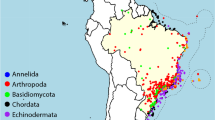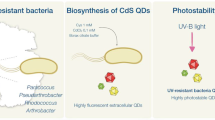Abstract
In the presence of the photosensitizer riboflavin, Astasia accumulates in illuminated fields at high fluence rates. The quenchers of riboflavin excited states, NaN3 and KI, abolish the photodynamic effect of riboflavin. Crocetin, a 1O2 quencher, does not influence the photodynamic action of riboflavin while 1,4-benzoquinone very strongly depresses its effect. This indicates a type I pathway forming H2O2 as a photoproduct. The photodynamic effect is abolished by the addition of 10-5 M catalase which breaks down H2O2. Astasia shows chemoaccumulations around the opening of a capillary filled either with riboflavin (under high intensity irradiation) or H2O2 which proves the hypothesis that the photobehavioral response in the presence of riboflavin is based on a chemoresponse toward H2O2, produced when the dye is irradiated. The accumulation around the capillary opening is not due to a direct chemotactic movement of cells but rather to a chemophobic response which prevents the cells from swimming away from the chemoattractant.
Similar content being viewed by others
References
Borgers JA, Kitching JA (1956) Reaction of the flagellate Astasia longa in gradients of dissolved carbon dioxide. Proc Roy Soc London B144:506–519
Diehn B, Feinleib M, Haupt W, Hildebrand E, Lenci F, Nultsch W (1977)Terminology of behavioral responses of motile microorganisms. Photochem Photobiol 26:559–560
Foote CS (1976) Photosensitized oxidation and singlet oxygen: Consequences in biological systems. In: Pryor WA (ed) Free radicals in biology, vol 2. Academic Press, New York, pp 85–133
Fontes AG, de la Rosa FF, Gomez-Moreno C (1981) Continuous photochemical production of hydrogen peroxide catalyzed by flavins. Photobiochem Photobiophys 2:355
Gössel I (1957) Über das Aktionsspektrum der Phototaxis chlorophyllfreier Euglenen und über die Absorption des Augenflecks. Arch Mikrobiol 27:288–305
Häder D-P, Lebert M (1985) Computer analysis of motile microorganisms. Photochem Photobiol(in press)
Häder M (1984) Light-induced chemotactic reactions in the dinoflagellate, Peridinopsis berolinensis. Photochem Photobiol 40:533–537
Ito T (1977) Cellular and subcellular mechanisms of photodynamic action: the 1O2 hypothesis as a driving force in recent research. Photochem Photobiol 28:493–508
Ito T (1983) Photodynamic agents as tools for cell biology. In: Smith KC (ed) Photochemical and photobiological reviews, vol 7. Plenum Press, New York, pp 141–186
Kumar HD, Nultsch W (1985) Effects of saffron extract and carotenoid preparations on the photodynamically induced chemotactic response of Polytomella magna. Photobiochem Photobiophys 9:39–42
Metzner P (1920) Über die Wirkung photodynamischer Stoffe auf Spirillum volutans und die Beziehung der photodynamischen Erscheinung zur Phototaxis. I. Mitteilung. Biochem Z 101:33–53
Metzner P (1921) Zur Kenntnis der photodynamischen Erscheinung. II. Mitteilung: Die induzierte Phototaxis bei Paramaecium caudatum. Biochem Z 113:145–175
Metzner P (1924) Zur Kenntnis der photodynamischen Erscheinung. III. Mitteilung: Über die Bindung der wirksamen Farbstoffe in der Zelle. Biochem Z 148:498–523
Mikolajczyk E (1984) Photophobic responses in Euglenina: 2. Sensitivity to light of the colorles flagellateAstasia longa in low and high viscosity medium. Acta Protozool 23:85–92
Mikolajczyk E, Kuznicki L (1984) Speculation on the origin of two photoreaction systems in Euglena. Progress Cell Biol 11:411–413
Nultsch W, Häder M (1984) Light-induced chemotactic responses of the colorless flagellate, Polytomella magna, in the presence of photodynamic dyes. Arch Microbiol 139:21–27
Nultsch W, Häder M (1985) Photodynamically induced behavioural responses of the colorless flagellate Polytomella magna: Effects of methylene blue. Proc Indian Acad Sci94:475–485
Nultsch W, Kumar HD (1984) Effects of quenching agents on the photodynamically-induced chemotactic response of the colorless flagellate Polytomella magna.Photochem Photobiol 40:539–543
Pringsheim EG (1942) Contributions to our knowledge of saprophytic algae and flagellata. III. Astasia, Distigma, Menoidium and Rhabdomonas. New Phytol 41:171–205
Pringsheim EG (1948) Taxonomic problems in the Euglenineae. Biol Rev 23:46–61
Pringsheim EG, Hovasse R (1948) The loss of chromatophores in Euglena gracilis. New Phytol 47:52–87
Spikes JD, Straight R (1981) The sensitized photooxidation of biomolecules, an overview. In: Rodgers MAJ, Powers EL (eds) Oxygen and oxy-radicals in chemistry and biology, Academic Press, New York, pp 421–424
Starr RC (1964) The culture collection of algae at Indiana University. Am J Bot 51:1013–1044
Suzuki T, Williamson RE (1983) Photoresponse of a colorless euglenoid flagellate, Astasi longa. Plant Science Lett 32:101–107
Author information
Authors and Affiliations
Rights and permissions
About this article
Cite this article
Mikolajczyk, E., Häder, DP. & Nultsch, W. Photodynamically induced chemoresponses of the colorless flagellate, Astasia longa, in the presence of riboflavin. Arch. Microbiol. 142, 397–402 (1985). https://doi.org/10.1007/BF00491911
Received:
Accepted:
Issue Date:
DOI: https://doi.org/10.1007/BF00491911




